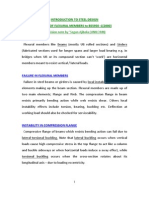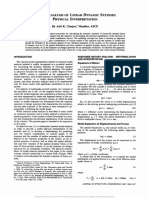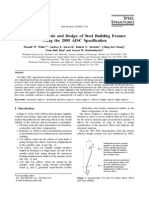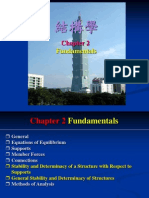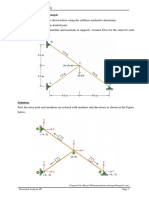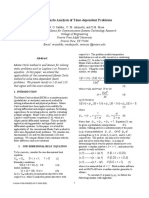Modal Analysis
Uploaded by
Trinh Duy TanModal Analysis
Uploaded by
Trinh Duy Tan+UC-SDRL-RJA CN-20-263-663/664 Revision: June 7, 1999 +
2. MODAL ANALYSIS THEORY
2.1 Introduction
While modal analysis theory has not changed over the last century, the application of the theory
to experimentally measured data has changed signicantly. The advances of recent years, with
respect to measurement and analysis capabilities, have caused a reevaluation of what aspects of
the theory relate to the practical world of testing. With this in mind, the aspect of transform
relationships has taken on renewed importance since digital forms of the integral transforms are
in constant use. The theory from the vibrations point of view inv olves a more thorough
understanding of how the structural parameters of mass, damping, and stiffness relate to the
impulse response function (time domain), the frequency response function (Fourier, or frequency
domain), and the transfer function (Laplace domain) for single and multiple degree of freedom
systems.
2.2 Transform Relationships
One of the keys to understanding experimental modal analysis involves the comprehension of the
relationships between the different domains used to describe the dynamics of a structural system.
Historically, this has involved the time, frequency (Fourier), and Laplace domains. These
relationships, with respect to a structural system, are the integral transforms (Fourier and
Laplace) that reect the information contained by the governing differential equations
transformed to each domain. It is important to note that these are integral relationships and that
the governing differential equations represent continuous relationships in each domain. As the
digital approach to the measurement of data is considered, similar relationships between time,
frequency, and Z domains can be formed that reect the information contained by the governing
nite difference equations in each domain. The relationships in this discrete case are represented
by discrete transforms (Discrete Fourier Transform, Z Transform). Whether the concept is
approached from the continuous or discrete case, the idea of the transform relationship is of
primary importance.
The concept of a transform is obviously very special. In general, there are four criteria for a
mathematical process to be designated as a transform. First, the transform process must involve
(2-1)
+UC-SDRL-RJA CN-20-263-663/664 Revision: June 7, 1999 +
a change of independent variable which represents the change from one domain to another.
Second, the transformed variable must be the variable of interest. Third, the transform process
must be computationally very simple but unique. Finally, there must be no loss of information in
the transform process. This last criteria is often the true distinction between a transform and
some form of parameter estimation. Since, with respect to modal analysis, the concepts of
transforms and parameter estimation are both important, this distinction is a very important one.
2.2.1 Transform Properties
The properties of transforms must be well understood in order to process data into measurements
efciently and without error. Digital data is always truncated to a limited time period and is
often multiplied by a time varying function in order to enhance certain characteristics in the data.
This sort of alteration of the data in the time domain has distinctly unique but often bewildering
effects in another domain if the properties of the transform are not considered.
While the complete list of transform properties for each transform can be found in numerous
applied mathematics handbooks
[1-3]
, sev eral properties should be noted due to their frequent
application in digital signal processing. First, scalar multiplication is commutative within and
between domains. Therefore, calibration of signals using constant calibration factors can be
performed without detrimental effect in any domain. Second, the multiplication of two functions
in one domain is equivalent to the convolution of the transformed functions in the resulting
domain. This property is essential for explaining the effects of weighting functions applied in
the time domain as a possible way of minimizing the effects of the bias error that will occur due
to the truncation of the data in the time domain (leakage error). Third, differentiation in the time
domain with respect to the independent time variable is equivalent to multiplication in the
transformed domain by the transformed variable. This property gives a very simple algebraic
way to convert data from acceleration to velocity or displacement in the frequency or Laplace
domains via multiplication. Finally, the shift theorem, which involves multiplying the time
domain data by a complex function of a shift frequency [ Cos(t) + j Sin(t) ] is the basis for
most frequency-shifted Fourier transform algorithms (Zoom) used in digital signal analyzers
today. The schematic of this frequency-shifted Fourier transform process is shown in Figure 2-1
for a shift of f
c
Hertz.
(2-2)
+UC-SDRL-RJA CN-20-263-663/664 Revision: June 7, 1999 +
Figure 2-1. Zoom Transform Process
2.3 Single Degree of Freedom Systems
In order to understand modal analysis, the comprehension of single degree of freedom systems is
necessary. In particular, the complete familiarity with single degree of freedom systems as
presented and evaluated in the time, frequency (Fourier), and Laplace domains serves as the basis
for many of the models that are used in modal parameter estimation. This single degree of
freedom approach is obviously trivial for the modal analysis case. The true importance of this
approach results from the fact that the multiple degree of freedom case can be viewed as simply a
linear superposition of single degree of freedom systems.
(2-3)
+UC-SDRL-RJA CN-20-263-663/664 Revision: June 7, 1999 +
M
K
C
f (t)
x(t)
Figure 2-2. Single Degree of Freedom System
The general mathematical representation of a single degree of freedom system is expressed in
Equation (2.1):
M x(t) + C x(t) + K x(t) f (t) (2.1)
where:
M Mass constant
C Damping constant
K Stiffness constant
By setting f (t) = 0, the homogeneous form of Equation (2.1) can be solved.
M x(t) + C x(t) + K x(t) 0 (2.2)
(2-4)
+UC-SDRL-RJA CN-20-263-663/664 Revision: June 7, 1999 +
From differential equation theory, the solution can be assumed to be of the form x(t) X e
st
,
where s is a complex constant to be determined. Taking appropriate derivatives and substituting
into Equation (2.2) yields:
( M s
2
+ C s + K ) X e
st
0 (2.3)
Thus, for a non-trivial solution:
M s
2
+ C s + K 0 (2.4)
where:
s Complex-valued frequency variable (Laplace variable)
Equation (2.4) is the characteristic equation of the system, whose roots
1
and
2
are:
1,2
C
2M
t
'
C
2M
_
,
2
K
M
_
,
1
2
(2.5)
Thus the general solution of Equation (2.2) is:
x(t) Ae
1
t
+ Be
2
t
(2.6)
A and B are constants determined from the initial conditions imposed on the system at time t = 0.
For most real structures, unless active damping systems are present, the damping ratio is rarely
greater than ten percent. For this reason, all further discussion is restricted to underdamped
systems ( < 1). With reference to Eq. (2.6), this means that the two roots,
1,2
, are always
complex conjugates. Also, the two coefcients (A and B) are complex conjugates of one another
( A and A
*
). For an underdamped system, the roots of the characteristic equation can be written
as:
1
1
+ j
1
*
1
1
j
1
(2.7)
where:
(2-5)
+UC-SDRL-RJA CN-20-263-663/664 Revision: June 7, 1999 +
1
Damping factor
1
Damped natural frequency
The roots of characteristic Equation (2.4) can also be written as:
1,
*
1
1
1
t j
1
1
2
1
(2.8)
The damping factor,
1
, is dened as the real part of a root of the characteristic equation. The
damping factor describes the exponential decay or growth of the oscillation. This parameter has
the same units as the imaginary part of the root of the characteristic equation, typically radians
per second.
With respect to the above result, critical damping and damping ratio can now be dened.
Critical damping, C
c
, is dened as being the damping which reduces the radical in the solution
of the characteristic equation to zero. This form of representing the damping is a physical
approach and therefore involves the appropriate units for equivalent viscous damping.
C
c
2M
K
M
2M
1
(2.9)
The fraction of critical damping, or damping ratio, , is the ratio of the actual system damping
to the critical system damping. This approach to the description of damping is dimensionless
since the units have been normalized.
1
C
C
c
1
1
(2.10)
2.3.1 Time Domain: Impulse Response Function
The impulse response function of the single degree of freedom system can be determined from
Equation (2.6) assuming that the initial conditions are zero and that the system excitation, f (t), is
a unit impulse. The response of the system, x(t), to such a unit impulse is known as the impulse
response function, h(t), of the system. Therefore:
(2-6)
+UC-SDRL-RJA CN-20-263-663/664 Revision: June 7, 1999 +
h(t) A e
1
t
+ A
*
e
*
1
t
(2.11)
h(t) e
1
t
A e
(+ j
1
t)
+ A
*
e
( j
1
t)
1
]
(2.12)
Thus, the coefcients ( A and A
*
) control the amplitude of the impulse response, the real part of
the pole is the decay rate and the imaginary part of the pole is the frequency of oscillation.
Figure 2-3 illustrates the impulse response function, for a single degree of freedom system.
0 10 20 30 40 50 60
-0.04
-0.02
0
0.02
0.04
0.06
0.08
Time (Sec.)
A
m
p
l
i
t
u
d
e
Figure 2-3. Time Domain: Impulse Response Function
(2-7)
+UC-SDRL-RJA CN-20-263-663/664 Revision: June 7, 1999 +
2.3.2 Frequency Domain: Frequency Response Function
An equivalent equation of motion for Equation (2.1) is determined for the Fourier or frequency
() domain. This representation has the advantage of converting a differential equation to an
algebraic equation. This is accomplished by taking the Fourier transform of Equation (2.1).
Thus, Equation (2.1) becomes:
M
2
+ j C + K
1
]
X() F() (2.13)
Restating the above equation:
B() X() F() (2.14)
where:
B() M
2
+ j C + K
Equation (2.14) states that the system response X() is directly related to the system forcing
function F() through the quantity B(), the impedance function. If the system forcing
function F() and its response X() are known, B() can be calculated. That is:
B()
F()
X()
(2.15)
More frequently, the system response, X(), due to a known input F(), is of interest.
X()
F()
B()
(2.16)
Equation (2.16) becomes:
X() H() F() (2.17)
where:
(2-8)
+UC-SDRL-RJA CN-20-263-663/664 Revision: June 7, 1999 +
H()
1
M
2
+ j C + K
The quantity H() is known as the frequency response function of the system. The frequency
response function relates the Fourier transform of the system input to the Fourier transform of the
system response. From Equation (2.17), the frequency response function can be dened as:
H()
X()
F()
(2.18)
Going back to Equation (2.13), the frequency response function can be written:
H()
1
M
2
+ j C + K
1/M
2
+ j
C
M
_
,
+
K
M
_
,
(2.19)
The denominator of Equation (2.19) is known as the characteristic equation of the system and is
of the same form as Equation (2.4). The characteristic values of this complex equation are in
general complex even though the equation is a function of a real valued independent variable ().
The characteristic values of this equation are known as the complex roots of the characteristic
equation or the complex poles of the system. These characteristic values are also called the
modal frequencies.
The frequency response function H() can also be written as a function of the complex poles as
follows:
H()
1/M
( j
1
) ( j
*
1
)
A
( j
1
)
+
A
*
( j
*
1
)
(2.20)
where:
1
Complex pole
1
+ j
1
*
1
j
1
Since the frequency response function is a complex valued function of a real valued independent
(2-9)
+UC-SDRL-RJA CN-20-263-663/664 Revision: June 7, 1999 +
variable (), the frequency response function, as shown in Figures 2-4 through 2-6 is represented
by a pair of curves.
0 50 100 150
1.5
1
0.5
0
0.5
1
1.5
x 10
3
Frequency (Hz)
R
e
a
l
0 50 100 150
2.5
2
1.5
1
0.5
0
x 10
3
Frequency (Hz)
I
m
a
g
i
n
a
r
y
(2-10)
+UC-SDRL-RJA CN-20-263-663/664 Revision: June 7, 1999 +
Figure 2-4. Frequency Response Function (Real/Imaginary Format)
0 50 100 150
0
0.5
1
1.5
2
2.5
x 10
3
Frequency (Hz)
M
a
g
n
i
t
u
d
e
0 50 100 150
180
160
140
120
100
80
60
40
20
0
Frequency (Hz)
P
h
a
s
e
(
D
e
g
)
Figure 2-5. Frequency Response Function (Magnitude/Phase Format)
(2-11)
+UC-SDRL-RJA CN-20-263-663/664 Revision: June 7, 1999 +
0 50 100 150
10
6
10
5
10
4
10
3
10
2
Frequency (Hz)
L
o
g
M
a
g
n
i
t
u
d
e
0 50 100 150
180
160
140
120
100
80
60
40
20
0
Frequency (Hz)
P
h
a
s
e
(
D
e
g
)
Figure 2-6. Frequency Response Function (Log Magnitude/Phase Format)
2.3.3 Laplace Domain: Transfer Function
Just as in the previous case for the frequency domain, the equivalent information can be
presented in the Laplace domain by way of the Laplace transform. The only signicant
difference in the development concerns the fact that the Fourier transform is dened from
(2-12)
+UC-SDRL-RJA CN-20-263-663/664 Revision: June 7, 1999 +
negative innity to positive innity while the Laplace transform is dened from zero to positive
innity with initial conditions. The Laplace representation, also, has the advantage of converting
a differential equation to an algebraic equation. The development using Laplace transforms
begins by taking the Laplace transform of Equation (2.1). Thus, Equation (2.1) becomes:
M s
2
+ C s + K
1
]
X(s) F(s) + [ M s + C ] X(0) + M
X(0) (2.21)
X(0) and
X(0) are the initial displacements and velocities at time t = 0.
If the initial conditions are zero, Equation (2.21) becomes:
M s
2
+ C s + K
1
]
X(s) F(s) (2.22)
Then, Equation (2.22) becomes:
B(s) X(s) F(s) (2.23)
where:
B(s) M s
2
+ C s + K
Therefore, using the same logic as in the frequency domain case, the transfer function can be
dened in the same way that the frequency response function was dened previously.
X(s) H(s) F(s) (2.24)
where:
H(s)
1
M s
2
+ C s + K
The quantity H(s) is dened as the transfer function of the system. In other words, a transfer
function relates the Laplace transform of the system input to the Laplace transform of the system
response. From Equation (2.24), the transfer function can be dened as:
H(s)
X(s)
F(s)
(2.25)
(2-13)
+UC-SDRL-RJA CN-20-263-663/664 Revision: June 7, 1999 +
Going back to Equation (2.22), the transfer function can be written:
H(s)
1
M s
2
+ C s + K
1/M
s
2
+
C
M
_
,
s +
K
M
_
,
(2.26)
Note that Equation (2.26) is valid under the assumption that the initial conditions are zero.
The denominator term is once again referred to as the characteristic equation of the system. As
noted in the previous two cases, the roots of the characteristic equation are given in Equation
(2.5).
The transfer function, H(s), can now be rewritten, just as in the frequency response function
case, as:
H(s)
1/M
(s
1)
(s
*
1
)
A
(s
1
)
+
A
*
(s
*
1
)
(2.27)
Since the transfer function is a complex valued function of a complex independent variable (s),
the transfer function is represented, as shown in Figures 2-7 through 2-9, as a pair of surfaces.
Remember that the variable s in Equation (2.27) is a complex variable, that is, it has a real part
an imaginary part. Therefore, it can be viewed as a function of two variables which represent a
surface.
(2-14)
+UC-SDRL-RJA CN-20-263-663/664 Revision: June 7, 1999 +
-0.2
-0.15
-0.1
-0.05
0
-1
-0.5
0
0.5
1
-10
-5
0
5
10
-0.2
-0.15
-0.1
-0.05
0
-1
-0.5
0
0.5
1
-6
-4
-2
0
2
4
6
Figure 2-7. Transfer Function (Real/Imaginary Format)
(2-15)
+UC-SDRL-RJA CN-20-263-663/664 Revision: June 7, 1999 +
-0.2
-0.15
-0.1
-0.05
0
-1
-0.5
0
0.5
1
0
2
4
6
8
10
-0.2
-0.15
-0.1
-0.05
0
-1
-0.5
0
0.5
1
-4
-2
0
2
4
Figure 2-8. Transfer Function (Magnitude/Phase Format)
(2-16)
+UC-SDRL-RJA CN-20-263-663/664 Revision: June 7, 1999 +
-0.2
-0.15
-0.1
-0.05
0
-1
-0.5
0
0.5
1
-3
-2
-1
0
1
2
3
-0.2
-0.15
-0.1
-0.05
0
-1
-0.5
0
0.5
1
-4
-2
0
2
4
Figure 2-9. Transfer Function (Log Magnitude/Phase Format)
(2-17)
+UC-SDRL-RJA CN-20-263-663/664 Revision: June 7, 1999 +
The denition of undamped natural frequency, damped natural frequency, damping factor,
percent of critical damping, and residue are all relative to the information represented by Figures
2-6 through 2-9. The projection of this information onto the plane of zero amplitude yields the
information as shown in Figure 2-10.
r
j
r
r
- damping factor (or percent of critical damping)
pole location
- resonant (undamped natural frequency)
= cos
- damped natural frequency
- damping coefficient
s = + j
r
X
X
conjugate pole
Figure 2-10. Transfer Function - LaPlace Plane Projection)
The concept of residues is now dened in terms of the partial fraction expansion of the transfer
function equation. Equation (2.27) can be expressed in terms of partial fractions:
H(s)
1/M
(s
1
) (s
*
1
)
A
(s
1
)
+
A
*
(s
*
1
)
(2.28)
The residues of the transfer function are dened as being the constants A and A
*
. The
terminology and development of residues comes from the evaluation of analytic functions in
(2-18)
+UC-SDRL-RJA CN-20-263-663/664 Revision: June 7, 1999 +
complex analysis. The residues of the transfer function are directly related to the amplitude of
the impulse response function. In general, the residue A can be a complex quantity. As shown
for a single degree of freedom system, A is purely imaginary.
At this point, it can be noted that the Laplace transform formulation is simply the general case of
the Fourier transform development if the initial conditions are zero. The frequency response
function is the part of the transfer function evaluated along the s j axis.
From an experimental point of view, the transfer function is not estimated from measured input-
output data. Instead, the frequency response function is actually estimated via the discrete
Fourier transform.
2.4 Multiple Degree of Freedom Systems
The real application of modal analysis concepts begin when a continuous, non-homogeneous
structure is described as a lumped mass, multiple degree-of-freedom system. At this point, the
modal frequencies, the modal damping, and the modal vectors, or relative patterns of motion, can
be found via an estimate of the mass, damping, and stiffness matrices or via the measurement of
the associated frequency response functions. The two degree of freedom system, shown in
Figure 2-11, is the most basic example of a multiple degree of freedom system. This example is
a useful means for discussing modal analysis concepts since a theoretical solution can be
formulated in terms of the mass, stiffness, and damping matrices or in terms of the frequency
response functions.
(2-19)
+UC-SDRL-RJA CN-20-263-663/664 Revision: June 7, 1999 +
M
1
M
2
K
1
C
1
K
2
C
2
K
3
C
3
f
1
(t)
x
1
(t)
f
2
(t)
x
2
(t)
Figure 2-11. Multi-Degree of Freedom System)
The equations of motion for the system in Figure 2-11, using matrix notation, are as follows:
M
1
0
0
M
2
1
1
]
x
1
x
2
1
1
]
+
(C
1
+ C
2
)
C
2
C
2
(C
2
+ C
3)
1
1
]
x
1
x
2
1
1
]
+
(K
1
+ K
2
)
K
2
K
2
(K
2
+ K
3
)
1
1
]
x
1
x
2
1
1
]
f
1
f
2
1
1
]
. (2.29)
The process of solving Equation (2.29) when the mass, damping, and stiffness matrices are
known is shown in almost every classical text concerning vibrations
[4-6]
.
The development of the frequency response function solution for the multiple degree of freedom
case parallels the single degree-of-freedom case. This development relates the mass, damping,
and stiffness matrices to a transfer function model involving multiple degrees of freedom. Just as
in the analytical case where the ultimate solution can be described in terms of one degree of
freedom systems, the frequency response functions between any input and response degree of
(2-20)
+UC-SDRL-RJA CN-20-263-663/664 Revision: June 7, 1999 +
freedom can be represented as a linear superposition of the single degree of freedom models
derived previously.
As a result of the linear superposition concept, the equations for the impulse response function,
the frequency response function, and the transfer function for the multiple degree of freedom
system are dened as follows:
Impulse Response Function
[h(t) ]
N
r1
A
r
1
]
e
r
t
+
A
*
r
1
]
e
*
r
t
2N
r1
A
r
1
]
e
r
t
(2.30)
Frequency Response Function
[H() ]
N
r1
A
r
1
]
j
r
+
A
*
r
1
]
j
*
r
2N
r1
A
r
1
]
j
r
(2.31)
Transfer Function
[H(s) ]
N
r1
A
r
1
]
s
r
+
A
*
r
1
]
s
*
r
2N
r1
A
r
1
]
s
r
(2.32)
where:
t Time variable
Frequency variable
s Laplace variable
p Measured degree of freedom (output)
(2-21)
+UC-SDRL-RJA CN-20-263-663/664 Revision: June 7, 1999 +
q Measured degree of freedom (input)
r Modal vector number
A
pqr
Residue
A
pqr
Q
r
pr
qr
Q
r
Modal scaling factor
pr
Modal coefcient
r
System pole
N Number of positive modal frequencies
It is important to note that the residue, A
pqr
, in Equations (2.30) through (2.32) is the product of
the modal deformations at the input q and response p degrees of freedom and a modal scaling
factor for mode r. Therefore, the product of these three terms is unique but each of the three
terms by themselves is not unique. This is consistent with the arbitrary normalization of the
modal vectors. Modal scaling, Q
r
, refers to the relationship between the normalized modal
vectors and the absolute scaling of the mass matrix (analytical case) and/or the absolute scaling
of the residue information (experimental case). Modal scaling is normally presented as modal
mass or modal A.
The driving point residue, A
qqr
, is particularly important in deriving the modal scaling.
A
qqr
Q
r
qr
qr
Q
r
2
qr
(2.33)
For undamped and proportionally damped systems, the r-th modal mass of a multi-degree of
freedom system can be dened as:
Modal Mass
M
r
1
j 2 Q
r
r
pr
qr
j 2 A
pqr
r
(2.34)
where:
(2-22)
+UC-SDRL-RJA CN-20-263-663/664 Revision: June 7, 1999 +
M
r
= Modal mass
Q
r
= Modal scaling constant
r
= Damped natural frequency
If the largest scaled modal coefcient is equal to unity, Equation 2.34 will also compute a
quantity of modal mass that has physical signicance. The physical signicance is that the
quantity of modal mass computed under these conditions will be a number between zero and the
total mass of the system. Therefore, under this scaling condition, the modal mass can be viewed
as the amount of mass that is participating in each mode of vibration. Obviously, for a
translational rigid body mode of vibration, the modal mass should be equal to the total mass of
the system.
The modal mass dened in Equation 2.34 is developed in terms of displacement over force units.
If measurements, and therefore residues, are developed in terms of any other units (velocity over
force or acceleration over force), Equation 2.34 will have to be altered accordingly.
Once the modal mass is known, the modal damping and modal stiffness can be obtained through
the following single degree of freedom equations:
Modal Damping
C
r
2
r
M
r
(2.35)
Modal Stiffness
K
r
(
2
r
+
2
r
) M
r
2
r
M
r
(2.36)
For systems with nonproportional damping, modal mass cannot be used for modal scaling. For
this case, and increasingly for undamped and proportionally damped cases as well, the modal A
scaling factor is used as the basis for the relationship between the scaled modal vectors and the
residues determined from the measured frequency response functions. This relationship is as
follows:
Modal A
(2-23)
+UC-SDRL-RJA CN-20-263-663/664 Revision: June 7, 1999 +
M
A
r
pr
qr
A
pqr
1
Q
r
(2.37)
This denition of modal A is also developed in terms of displacement over force units. Once
modal A is known, modal B can be obtained through the following single degree of freedom
equation:
Modal B
M
B
r
r
M
A
r
(2.38)
For undamped and proportionally damped systems, the relationship between modal mass and
modal A scaling factors can be stated.
M
A
r
t j2M
r
r
(2.39)
In general, modal vectors are considered to be dimensionless since they represent relative
patterns of motion. Therefore, the modal mass or modal A scaling terms carry the units of the
respective measurement. For example, the development of the frequency response is based upon
displacement over force units. The residue must therefore, have units of length over force-
seconds. Since the modal A scaling coefcient is inversely related to the residue, modal A will
have units of force-seconds over length. This unit combination is the same as mass over seconds.
Likewise, since modal mass is related to modal A, for proportionally damped systems, through a
direct relationship involving the damped natural frequency, the units on modal mass are mass
units as expected.
The following table summarizes the units of modal A and modal mass for typical consistent unit
applications.
(2-24)
+UC-SDRL-RJA CN-20-263-663/664 Revision: June 7, 1999 +
Consistent Units Relationships
Mass Force Length Modal A (M
Ar
) Modal Mass (M
r
)
M F L M/S M
KG NT Meter KG/S KG
KG KGf g-S-S KG/S KG
LBm LBf g-S-S LBm/S LBm
Slug LBf Feet Slug/S Slug
Table 2-1. Modal Scaling Units
2.5 Damping Mechanisms
In order to evaluate multiple degree of freedom systems that are present in the real world, the
effect of damping on the complex frequencies and modal vectors must be considered. Many
physical mechanisms are needed to describe all of the possible forms of damping that may be
present in a particular structure or system. Some of the classical types are: 1) Structural
Damping; 2) Viscous Damping; and 3) Coulomb Damping. It is generally difcult to ascertain
which type of damping is present in any particular structure. Indeed most structures exhibit
damping characteristics that result from a combination of all the above, plus others that have not
been described here.
Rather than consider the many, different physical mechanisms, the probable location of each
mechanism, and the particular mathematical representation of the mechanism of damping that is
needed to describe the dissipative energy of the system, a model will be used that is only
concerned with the resultant mathematical form. This model will represent a hypothetical form
of damping, that is proportional to the system mass or stiffness matrix. Therefore:
[ C ] [ M ] + [ K ] (2.40)
Under this assumption, proportional damping is the case where the equivalent damping matrix
is equal to a linear combination of the mass and stiffness matrices. For this mathematical form
of damping, the coordinate transformation that diagonalizes the system mass and stiffness
matrices, also diagonalizes the system damping matrix. Nonproportional damping is the case
(2-25)
+UC-SDRL-RJA CN-20-263-663/664 Revision: June 7, 1999 +
where this linear combination does not exist.
Therefore when a system with proportional damping exists, that system of coupled equations of
motion can be transformed to a system of equations that represent an uncoupled system of single
degree-of-freedom systems that are easily solved. With respect to modal parameters, a system
with proportional damping has real-valued modal vectors ( real or normal modes) while a
system with nonproportional damping has complex-valued modal vectors( complex modes) .
2.6 References
[1] LePage, W.R., Complex Variables and the Laplace Transform for Engineers, Dover Publications, Inc.,
New York, 1961, 475 pp.
[2] Selby, S.M., CRC Standard Mathematical Tables, Fifteen Edition, The Chemical Rubber Company,
1967, 664 pp.
[3] Spiegel, M.R., Mathematical Handbook of Formulas and Tables, Schaums Outline Series in
Mathematics, McGraw-Hill, Inc., 1968,271 pp.
[4] Tse, F.S., Morse, I.E., Jr., Hinkle, R.T., Mechanical Vibrations: Theory and Applications, Second
Edition, Prentice-Hall, Inc., Englewood Cliffs, New Jersey, 1978, 449 pp.
[5] Craig, R.R., Jr., Structural Dynamics: An Introduction to Computer Methods, John Wiley and Sons,
Inc., New York, 1981, 527 pp.
[6] Ewins, D., Modal Testing: Theory and Practice John Wiley and Sons, Inc., New York, 1984, 269 pp.
(2-26)
You might also like
- Designing Concrete Structures:: Acceptance of Concrete Compressive Strength Test Results According To ACI 318-19No ratings yetDesigning Concrete Structures:: Acceptance of Concrete Compressive Strength Test Results According To ACI 318-197 pages
- Dynamic Soil Structure Interaction - 02 - Chapter2 - Nagano100% (1)Dynamic Soil Structure Interaction - 02 - Chapter2 - Nagano42 pages
- Principle of Superposition - 3D Bernoulli BeamNo ratings yetPrinciple of Superposition - 3D Bernoulli Beam49 pages
- Filippou-Popov-Bertero, Modeling of RC Joints, ASCE 1983No ratings yetFilippou-Popov-Bertero, Modeling of RC Joints, ASCE 198320 pages
- Introduction To Nonlinear Geometry For Truss Structures: OutlineNo ratings yetIntroduction To Nonlinear Geometry For Truss Structures: Outline10 pages
- Kanakubo Toshiyuki, Petr Kabele, Hiroshi Fukuyama, Yuichi Uchida, Haruhiko Suwada, Volker Slowik (Auth.), Keitetsu Rokugo, Tetsushi Kanda (Eds.) Strain Hardening Cement Composites_ Structural Design and PerformNo ratings yetKanakubo Toshiyuki, Petr Kabele, Hiroshi Fukuyama, Yuichi Uchida, Haruhiko Suwada, Volker Slowik (Auth.), Keitetsu Rokugo, Tetsushi Kanda (Eds.) Strain Hardening Cement Composites_ Structural Design and Perform94 pages
- Galerkin Method For Bending Analysis of Beams On NNo ratings yetGalerkin Method For Bending Analysis of Beams On N12 pages
- Structural Dynamics and Earthquake EngineeringNo ratings yetStructural Dynamics and Earthquake Engineering76 pages
- CE 6705 Analysis & Design of Buildings Against Hazards: Professor T. BalendraNo ratings yetCE 6705 Analysis & Design of Buildings Against Hazards: Professor T. Balendra29 pages
- Dynamics of Structures and Soils: Deterministic Structural Dynamics. Random Stochastic or Random Structural DynamicsNo ratings yetDynamics of Structures and Soils: Deterministic Structural Dynamics. Random Stochastic or Random Structural Dynamics11 pages
- The Direct Stiffness Method: Assembly and SolutionNo ratings yetThe Direct Stiffness Method: Assembly and Solution14 pages
- An Improved Pushover Procedure For Engineering Practice - Incremental Response Spectrum Analysis (IRSA) - M Nurray Aydinoglu, 2004No ratings yetAn Improved Pushover Procedure For Engineering Practice - Incremental Response Spectrum Analysis (IRSA) - M Nurray Aydinoglu, 200412 pages
- S-FRAME Seismic Time History Analysis PDFNo ratings yetS-FRAME Seismic Time History Analysis PDF53 pages
- 39 - (Systems) (12) Radial Frame (2016)No ratings yet39 - (Systems) (12) Radial Frame (2016)64 pages
- (Nielson, B) - Analytical Fragility Curves For Highway Bridges in Moderate Seismic ZonesNo ratings yet(Nielson, B) - Analytical Fragility Curves For Highway Bridges in Moderate Seismic Zones400 pages
- Chopra Modal+Analysis+of+Linear+Dynamic+Systems PDFNo ratings yetChopra Modal+Analysis+of+Linear+Dynamic+Systems PDF11 pages
- Stability Analysis and Design of Steel Building Frame Using AISC 2005 Specification PDFNo ratings yetStability Analysis and Design of Steel Building Frame Using AISC 2005 Specification PDF21 pages
- About Pushover Analysis and SAP 2000 Method100% (2)About Pushover Analysis and SAP 2000 Method12 pages
- Shear Wall Modelling Techniques: A ReviewNo ratings yetShear Wall Modelling Techniques: A Review9 pages
- DTD Handbook: Section 2.2.6.3. Crack Opening DisplacementNo ratings yetDTD Handbook: Section 2.2.6.3. Crack Opening Displacement4 pages
- Vibrations and Dynamic Responses: Structural DynamicsNo ratings yetVibrations and Dynamic Responses: Structural Dynamics27 pages
- Application of Friction Pendulum System To The Main Control Room of A Nuclear Power PlantNo ratings yetApplication of Friction Pendulum System To The Main Control Room of A Nuclear Power Plant10 pages
- Analysis of Structures On Elastic Foundation Incorporating The Spectral Method of Boundary Elements (Levon G. Petrosian) (Z-Library) PDFNo ratings yetAnalysis of Structures On Elastic Foundation Incorporating The Spectral Method of Boundary Elements (Levon G. Petrosian) (Z-Library) PDF571 pages
- A Simplified Design Method For Metallic Dampers Used in The Transverse Direction of Cable-Stayed BridgesNo ratings yetA Simplified Design Method For Metallic Dampers Used in The Transverse Direction of Cable-Stayed Bridges15 pages
- (PEER-TURNER) Influence of Kinematic SSI On Foundation Input Motions For Bridges On Deep FoundationsNo ratings yet(PEER-TURNER) Influence of Kinematic SSI On Foundation Input Motions For Bridges On Deep Foundations226 pages
- Rev Topic04 StructuralDynamicsofMDOFSystemsNo ratings yetRev Topic04 StructuralDynamicsofMDOFSystems125 pages
- A Catalogue of Details on Pre-Contract Schedules: Surgical Eye Centre of Excellence - KathFrom EverandA Catalogue of Details on Pre-Contract Schedules: Surgical Eye Centre of Excellence - KathNo ratings yet
- Damage Mechanics in Metal Forming: Advanced Modeling and Numerical SimulationFrom EverandDamage Mechanics in Metal Forming: Advanced Modeling and Numerical Simulation4/5 (1)
- Methodologies for Seismic Safety Evaluation of Existing Nuclear InstallationsFrom EverandMethodologies for Seismic Safety Evaluation of Existing Nuclear InstallationsNo ratings yet
- Structural Engineering DocumentsFrom EverandStructural Engineering DocumentsJorge de BritoNo ratings yet
- Optimal Approximation of Analog PID Controllers of Complex Fractional-OrderNo ratings yetOptimal Approximation of Analog PID Controllers of Complex Fractional-Order28 pages
- Journal of Statistical Software: Warping Functional Data in R and C Via A Bayesian Multiresolution ApproachNo ratings yetJournal of Statistical Software: Warping Functional Data in R and C Via A Bayesian Multiresolution Approach22 pages
- Machines: Limit Cycles in Nonlinear Systems With Fractional Order PlantsNo ratings yetMachines: Limit Cycles in Nonlinear Systems With Fractional Order Plants26 pages
- 17 Lagrange Interpolation Mathematica ProgramNo ratings yet17 Lagrange Interpolation Mathematica Program14 pages
- Precalculus11 - Q2 - M3 - Inverse Trigonometric FunctionNo ratings yetPrecalculus11 - Q2 - M3 - Inverse Trigonometric Function46 pages
- HMMT February 2024 Algebra and Number Theory ANSWERSNo ratings yetHMMT February 2024 Algebra and Number Theory ANSWERS6 pages
- CoENG001L Midterm Lecture 2 Number Systems Conversions and Arithmetic and ComplementNo ratings yetCoENG001L Midterm Lecture 2 Number Systems Conversions and Arithmetic and Complement20 pages
- Practice Test Paper Functions Limits Continuity Differentiability Indefinite Integrals - Iit LevelNo ratings yetPractice Test Paper Functions Limits Continuity Differentiability Indefinite Integrals - Iit Level4 pages
- Lab # 5 Modeling of Translational Mechanical System and To Calculate Its Various ResponsesNo ratings yetLab # 5 Modeling of Translational Mechanical System and To Calculate Its Various Responses18 pages
- Core 1: Revision Past Paper Questions (Edexcel)No ratings yetCore 1: Revision Past Paper Questions (Edexcel)480 pages
- Designing Concrete Structures:: Acceptance of Concrete Compressive Strength Test Results According To ACI 318-19Designing Concrete Structures:: Acceptance of Concrete Compressive Strength Test Results According To ACI 318-19
- Dynamic Soil Structure Interaction - 02 - Chapter2 - NaganoDynamic Soil Structure Interaction - 02 - Chapter2 - Nagano
- Filippou-Popov-Bertero, Modeling of RC Joints, ASCE 1983Filippou-Popov-Bertero, Modeling of RC Joints, ASCE 1983
- Introduction To Nonlinear Geometry For Truss Structures: OutlineIntroduction To Nonlinear Geometry For Truss Structures: Outline
- Kanakubo Toshiyuki, Petr Kabele, Hiroshi Fukuyama, Yuichi Uchida, Haruhiko Suwada, Volker Slowik (Auth.), Keitetsu Rokugo, Tetsushi Kanda (Eds.) Strain Hardening Cement Composites_ Structural Design and PerformKanakubo Toshiyuki, Petr Kabele, Hiroshi Fukuyama, Yuichi Uchida, Haruhiko Suwada, Volker Slowik (Auth.), Keitetsu Rokugo, Tetsushi Kanda (Eds.) Strain Hardening Cement Composites_ Structural Design and Perform
- Galerkin Method For Bending Analysis of Beams On NGalerkin Method For Bending Analysis of Beams On N
- CE 6705 Analysis & Design of Buildings Against Hazards: Professor T. BalendraCE 6705 Analysis & Design of Buildings Against Hazards: Professor T. Balendra
- Dynamics of Structures and Soils: Deterministic Structural Dynamics. Random Stochastic or Random Structural DynamicsDynamics of Structures and Soils: Deterministic Structural Dynamics. Random Stochastic or Random Structural Dynamics
- The Direct Stiffness Method: Assembly and SolutionThe Direct Stiffness Method: Assembly and Solution
- An Improved Pushover Procedure For Engineering Practice - Incremental Response Spectrum Analysis (IRSA) - M Nurray Aydinoglu, 2004An Improved Pushover Procedure For Engineering Practice - Incremental Response Spectrum Analysis (IRSA) - M Nurray Aydinoglu, 2004
- (Nielson, B) - Analytical Fragility Curves For Highway Bridges in Moderate Seismic Zones(Nielson, B) - Analytical Fragility Curves For Highway Bridges in Moderate Seismic Zones
- Chopra Modal+Analysis+of+Linear+Dynamic+Systems PDFChopra Modal+Analysis+of+Linear+Dynamic+Systems PDF
- Stability Analysis and Design of Steel Building Frame Using AISC 2005 Specification PDFStability Analysis and Design of Steel Building Frame Using AISC 2005 Specification PDF
- DTD Handbook: Section 2.2.6.3. Crack Opening DisplacementDTD Handbook: Section 2.2.6.3. Crack Opening Displacement
- Vibrations and Dynamic Responses: Structural DynamicsVibrations and Dynamic Responses: Structural Dynamics
- Application of Friction Pendulum System To The Main Control Room of A Nuclear Power PlantApplication of Friction Pendulum System To The Main Control Room of A Nuclear Power Plant
- Analysis of Structures On Elastic Foundation Incorporating The Spectral Method of Boundary Elements (Levon G. Petrosian) (Z-Library) PDFAnalysis of Structures On Elastic Foundation Incorporating The Spectral Method of Boundary Elements (Levon G. Petrosian) (Z-Library) PDF
- A Simplified Design Method For Metallic Dampers Used in The Transverse Direction of Cable-Stayed BridgesA Simplified Design Method For Metallic Dampers Used in The Transverse Direction of Cable-Stayed Bridges
- (PEER-TURNER) Influence of Kinematic SSI On Foundation Input Motions For Bridges On Deep Foundations(PEER-TURNER) Influence of Kinematic SSI On Foundation Input Motions For Bridges On Deep Foundations
- A Catalogue of Details on Pre-Contract Schedules: Surgical Eye Centre of Excellence - KathFrom EverandA Catalogue of Details on Pre-Contract Schedules: Surgical Eye Centre of Excellence - Kath
- Damage Mechanics in Metal Forming: Advanced Modeling and Numerical SimulationFrom EverandDamage Mechanics in Metal Forming: Advanced Modeling and Numerical Simulation
- Methodologies for Seismic Safety Evaluation of Existing Nuclear InstallationsFrom EverandMethodologies for Seismic Safety Evaluation of Existing Nuclear Installations
- Optimal Approximation of Analog PID Controllers of Complex Fractional-OrderOptimal Approximation of Analog PID Controllers of Complex Fractional-Order
- Journal of Statistical Software: Warping Functional Data in R and C Via A Bayesian Multiresolution ApproachJournal of Statistical Software: Warping Functional Data in R and C Via A Bayesian Multiresolution Approach
- Machines: Limit Cycles in Nonlinear Systems With Fractional Order PlantsMachines: Limit Cycles in Nonlinear Systems With Fractional Order Plants
- Precalculus11 - Q2 - M3 - Inverse Trigonometric FunctionPrecalculus11 - Q2 - M3 - Inverse Trigonometric Function
- HMMT February 2024 Algebra and Number Theory ANSWERSHMMT February 2024 Algebra and Number Theory ANSWERS
- CoENG001L Midterm Lecture 2 Number Systems Conversions and Arithmetic and ComplementCoENG001L Midterm Lecture 2 Number Systems Conversions and Arithmetic and Complement
- Practice Test Paper Functions Limits Continuity Differentiability Indefinite Integrals - Iit LevelPractice Test Paper Functions Limits Continuity Differentiability Indefinite Integrals - Iit Level
- Lab # 5 Modeling of Translational Mechanical System and To Calculate Its Various ResponsesLab # 5 Modeling of Translational Mechanical System and To Calculate Its Various Responses





















